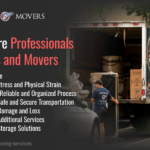Your growing business needs more space, but making a major transition can be hectic. Mistakes during an office move might cost you, and downtime kills your productivity. Smooth out the rough spots of your business relocation and get back to your regular working schedule with these tips.
Designate a Move Leader
A move coordinator assumes the burden of managing this project and frees you to focus on running your business. Appoint one member of your leadership team to oversee the move. This individual should have excellent project and team management skills.
Your move coordinator:
- Develops your relocation schedule, calendar, and checklist
- Plans and assigns move-related tasks to your staff
- Communicates with the move team, the moving company, and real estate agents
- Coordinates work between your staff and your contractors
- Schedules deliveries of new equipment
- Resolves issues as they arise
- Hold weekly meetings to discuss progress and send out regular updates to the rest of your staff.
Plan Maps, Strategies, and Schedules
Establish a moving schedule right away. This essential element organizes all related tasks and defines deadlines for completion. Depending on how complex your business needs are, you may require a year to organize and execute your move. So, start planning early.
Get the layout of the new office and create several rough sketches of how you want to place your furniture and equipment. You might even make cardboard cutouts and move them around the office plans until you have the perfect fit. Keep in mind the workflow and try to create a productive space.
Consider the sequence of the move. Strategize around your critical equipment, but during the actual move, start lifting and transferring your nonessentials first. This technique minimizes your downtime and clears the clutter away, so it’s easier to move critical items with fewer complications.
Hire a Professional Moving Company
Commercial movers specialize in office relocations. They have the equipment, supplies, people, and experience to get your office move completed quickly. Movers often save their customers money by reducing the amount of rework.
There are several levels of service:
- Basic Transportation – The movers load their truck with your boxes and furniture.
- Partial Pack – Movers provide labor to box and wrap certain items for you.
- Full Service – The moving team performs all packing and moving work for the whole of the office.
You will meet with the moving company’s representative several weeks before the event to strategize the transition. This walkthrough is your opportunity to finalize details and ask questions.
Some movers use color-coded labels to mark items. Other have more sophisticated barcodes and tags. They may also require your staff to pack their personal belongings and desks in provided containers. Make sure you understand special instructions and know how to explain those instructions to your team.
Contact a commercial moving company to request a quote as soon as possible. Secure a commitment for the work at least two months in advance of your transition, but you should begin soliciting quotes no less than six months before your move date. Verify licensing of any moving and only hire a reputable business. Also, ask about available insurance options. Most carry basic liability insurance, but this coverage only protects the movers for their business-related incidents.
For your expensive and critical items, purchase additional coverage to protect against move-related damages and losses. Full value coverage is the best option, but the more limited release value insurance has a lower premium. Ask if your move insurance protects against lost productivity due to damage of mission-critical equipment.
Notifications and Transferring Services
Changing your business address is far more complex than changing a residential address. More people are involved.
- Make a list of contacts and verify that each received notice:
- Inform your vendors, suppliers, and service providers
- Update creditors, banks, and insurance providers.
- Print new company stationery, business cards, and marketing materials
- Change your address on all websites and social media accounts
Also, contact your clients to inform them of your new location. You can even use this opportunity to reaffirm relationships and market your business.
Leave mail forwarding information at your old office. Follow up with your contacts within 30 days of the move to avoid interruptions in deliveries of essential materials.
Prioritize your IT Department
Many office moves falter when managers fail to consider the complexities of relocating the IT department. Involve your IT team in the planning right from the beginning and carefully consider their input.
Transfer your phone and internet services before you attempt to move your computer hardware. Try to complete the work of transitioning and setting up the equipment during a weekend or evening. Make sure you have a clear idea of how long a service interruption might last before you pull the plug on any of your critical data and communications systems.
Your New Start
Take the opportunity during your move to update processes and get rid of clutter. As you settle into your new environment, you’ll be glad you left wasteful habits behind.
And finally, enjoy your new office.
Imperial Moving & Storage would love to help you navigate the complexities of your upcoming business relocation. A licensed and insured NYC office mover, we provide commercial moving services to all five boroughs as well as nationwide. For a free moving quote, call now!












